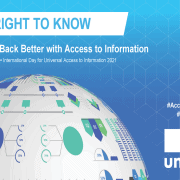|
Getting your Trinity Audio player ready...
|
Corruption Watch, in partnership with Transparency International, is working on a project called Open Contracting for Health (OC4H), which aims to advocate for greater transparency in health procurement processes.
The project developed from our engagements with other civil society organisations, when we became aware of a common frustration – efforts to monitor the implementation of tenders is undermined by the lack of access to information, while requests made under the Promotion of Access to Information Act are routinely met with the lawful ground of refusal that the information is commercially and legally sensitive.
Nobody needs to be reminded of the scandalous procurement abuse during the early days of the response to Covid-19. But as distressing as that was. It was just one of a long string of ongoing procurement scandals in all three levels of government, and the reason that the culprits continue to make off with their ill-gotten gains is partly because there was, and still is, a diminished capacity for third-party monitoring because of incompetence, inefficiency, opacity, and sheer disregard for Treasury regulations.
We therefore undertook legal research to determine, among others, exactly which information has to be published, ways to access it, and what is actually considered to be legally and commercially sensitive. This data would enable us to make recommendations on how the publication of such information can be improved.
The research was conducted on our behalf by Open Cities Lab. The work involved:
- Conducting a rapid assessment of national and provincial health procurement portals, assessing the availability of information on the portals (three national and nine provincial portals were selected for the rapid assessment).
- Selection of three portals for additional in-depth technical review, including:
- Scraping and development of a data catalogue using Open Contracting Data Standards (OCDS).
- Analysis to determine which procurement health indicators are possible using the available fields and data.
- Recommendations based on the above analysis including what additional fields should be included and what interventions should be prioritised by portal owners for improved procurement processes.
- Analysis on overlap and peculiarities of data on the portals when compared to each other.
The three portals selected for these deep dives were the eTenders publication portal, the North West Department of Health website (DoH) and the Gauteng Provincial Government tender information portal.
Download our policy document and full report.
Significant lack of quality data
Open Cities Lab notes in its research report that the exercise of reviewing and scraping the three procurement portals, developing a data catalogue, and assessing procurement indicators unearthed the lack of quality, complete data available on public health-related procurement portals in South Africa.
The review found that out of 69 potential indicators for eTenders, only seven could be calculated using the data catalogue developed, and out of 67 potential indicators for provincial portals, only three could be calculated per portal. The specific challenges leading to the inability to calculate indicators are categorised as data quality, transparency, and efficiency, and are reflective of a fairly immature procurement data management system that fails to publish basic information requirements.
Data quality across all three portals was poor, requiring significant effort to develop the data catalogue and preventing accurate indicator analysis. The following data quality issues were most common:
- Information being captured in the incorrect field, for example, telephone numbers being filled in where contract prices should be (Note: This was particularly true of eTenders. The provincial portals are more organised but also have much less data).
- Duplicate entries.
- Inconsistent naming conventions and typing errors.
- Incorrect or nonsensical dates (especially true for the Gauteng portal).
Besides these issues, the research uncovered significant inconsistency of data across the provincial portals and eTenders. It is legally required by National Treasury Instruction 1, 3 and 4 (2015/16) to publish provincial bids and awards on eTenders – however, very few provincially published tenders are also being published on eTenders and there are some tenders listed on eTenders that aren’t listed on the provincial portals.
Another major challenge related to the lack of information published. Without transparency, it is almost impossible to analyse factors such value for money. Again, Open Cities notes, the lack of transparency is often illegal in terms of the minimum standards set in National Treasury instructions 1, 3 and 4 of 2015/16.
Examples of inefficiency within the procuring process include:
- Delayed publishing of information, which is often illegal, for example, it is legislated that tenderer information is published within 10 days of the bid opening but this is not being done through the respective portals, and award information should be published timeously to allow time for challenges but awards are often published well after the award decision, especially on the provincial portals (if published at all).
- Most bids can only be submitted in person (100% of bids on the North West DoH website had to be submitted in person), which is inefficient and more costly for the tenderer. Furthermore, several provincial tenders are only available in hard copy from the provincial offices.
- Tenders are often open for longer than 21 days (100% of bids on the North West DoH website and 24% on the Gauteng provincial portal were open for longer than 21 days).
A major consequence of the above challenges is that corruption via these digital platforms cannot be adequately monitored – therefore the chances of corruption occurring are increased. The following recommendations aim to address these challenges and improve monitoring.
Recommendations
The following recommendations should be read together with the individual portal recommendations in previous sections.
Provincial portals
It is important to note that provincial portals are publishing significantly less information than eTenders (particularly in HTML), the data quality and consistency is poor, and there seems to be confusion and inconsistency regarding what is published on eTenders and what is published on the provincial portal. This is a breach in legislation. There are two scenarios that should be explored by provinces:
- Scenario 1: Desist from publishing tenders on a provincial portal/website and direct all tenderers to the national portal. Work with the national portal owners to improve the extent and quality of information published (see recommendations for the national portal below).
- Scenario 2: Drastically improve the extent and quality of information published on their portal/website and improve the synergies with the national portal (as required by legislation) (see detailed recommendations for the North West DoH and Gauteng, in the full report).
National portal
While there are notable shortcomings with eTenders, it is still the most comprehensive and effective procurement portal of the portals considered in the rapid assessment as part of this study. This proves that there is a place for a national portal such as eTenders within the procurement ecosystem. Two scenarios could be considered:
- Scenario 1: Update eTenders to the level required to meet SA legislation and aim for better transparency in future. Specific portal recommendations for eTenders that are phased appropriately can be found in the full report.
- Scenario 2: Replace eTenders with a new portal (or compliment eTenders with a new health procurement portal) that more easily allows for the implementation of OCDS and more automated processes. In order to decide if this is necessary, a technical assessment of eTenders and the associated data pipeline against OCDS and within the local context will need to take place.
Download our policy document and full report.







